Wenbo Chen
MCOP: Multi-UAV Collaborative Occupancy Prediction
Oct 14, 2025Abstract:Unmanned Aerial Vehicle (UAV) swarm systems necessitate efficient collaborative perception mechanisms for diverse operational scenarios. Current Bird's Eye View (BEV)-based approaches exhibit two main limitations: bounding-box representations fail to capture complete semantic and geometric information of the scene, and their performance significantly degrades when encountering undefined or occluded objects. To address these limitations, we propose a novel multi-UAV collaborative occupancy prediction framework. Our framework effectively preserves 3D spatial structures and semantics through integrating a Spatial-Aware Feature Encoder and Cross-Agent Feature Integration. To enhance efficiency, we further introduce Altitude-Aware Feature Reduction to compactly represent scene information, along with a Dual-Mask Perceptual Guidance mechanism to adaptively select features and reduce communication overhead. Due to the absence of suitable benchmark datasets, we extend three datasets for evaluation: two virtual datasets (Air-to-Pred-Occ and UAV3D-Occ) and one real-world dataset (GauUScene-Occ). Experiments results demonstrate that our method achieves state-of-the-art accuracy, significantly outperforming existing collaborative methods while reducing communication overhead to only a fraction of previous approaches.
GPTON: Generative Pre-trained Transformers enhanced with Ontology Narration for accurate annotation of biological data
Oct 12, 2024

Abstract:By leveraging GPT-4 for ontology narration, we developed GPTON to infuse structured knowledge into LLMs through verbalized ontology terms, achieving accurate text and ontology annotations for over 68% of gene sets in the top five predictions. Manual evaluations confirm GPTON's robustness, highlighting its potential to harness LLMs and structured knowledge to significantly advance biomedical research beyond gene set annotation.
Compact Optimality Verification for Optimization Proxies
May 31, 2024



Abstract:Recent years have witnessed increasing interest in optimization proxies, i.e., machine learning models that approximate the input-output mapping of parametric optimization problems and return near-optimal feasible solutions. Following recent work by (Nellikkath & Chatzivasileiadis, 2021), this paper reconsiders the optimality verification problem for optimization proxies, i.e., the determination of the worst-case optimality gap over the instance distribution. The paper proposes a compact formulation for optimality verification and a gradient-based primal heuristic that brings substantial computational benefits to the original formulation. The compact formulation is also more general and applies to non-convex optimization problems. The benefits of the compact formulation are demonstrated on large-scale DC Optimal Power Flow and knapsack problems.
Boosting Column Generation with Graph Neural Networks for Joint Rider Trip Planning and Crew Shift Scheduling
Jan 08, 2024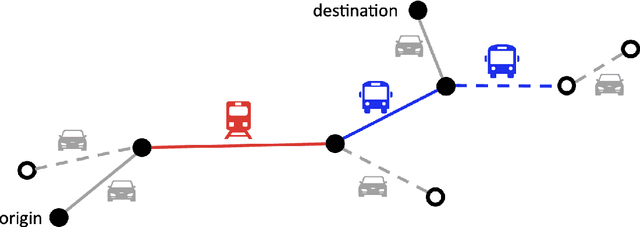
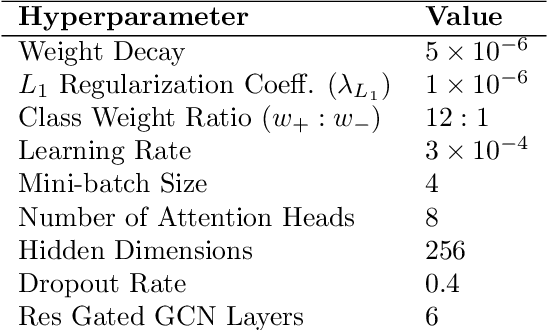

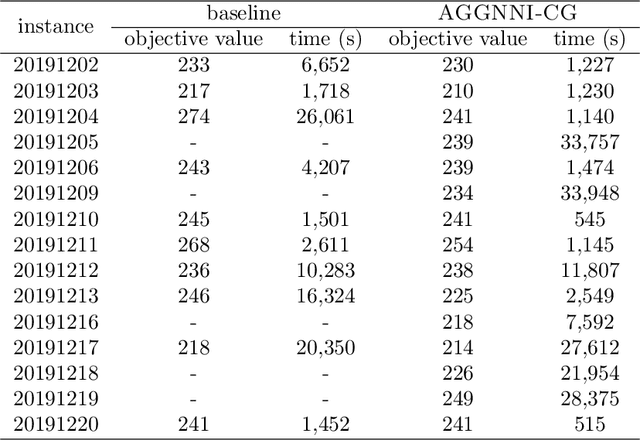
Abstract:Optimizing service schedules is pivotal to the reliable, efficient, and inclusive on-demand mobility. This pressing challenge is further exacerbated by the increasing needs of an aging population, the over-subscription of existing services, and the lack of effective solution methods. This study addresses the intricacies of service scheduling, by jointly optimizing rider trip planning and crew scheduling for a complex dynamic mobility service. The resulting optimization problems are extremely challenging computationally for state-of-the-art methods. To address this fundamental gap, this paper introduces the Joint Rider Trip Planning and Crew Shift Scheduling Problem (JRTPCSSP) and a novel solution method, called AGGNNI-CG (Attention and Gated GNN- Informed Column Generation), that hybridizes column generation and machine learning to obtain near-optimal solutions to the JRTPCSSP with the real-time constraints of the application. The key idea of the machine-learning component is to dramatically reduce the number of paths to explore in the pricing component, accelerating the most time-consuming component of the column generation. The machine learning component is a graph neural network with an attention mechanism and a gated architecture, that is particularly suited to cater for the different input sizes coming from daily operations. AGGNNI-CG has been applied to a challenging, real-world dataset from the Paratransit system of Chatham County in Georgia. It produces dramatic improvements compared to the baseline column generation approach, which typically cannot produce feasible solutions in reasonable time on both medium-sized and large-scale complex instances. AGGNNI-CG also produces significant improvements in service compared to the existing system.
Optimization-based Learning for Dynamic Load Planning in Trucking Service Networks
Jul 08, 2023Abstract:The load planning problem is a critical challenge in service network design for parcel carriers: it decides how many trailers (or loads) to assign for dispatch over time between pairs of terminals. Another key challenge is to determine a flow plan, which specifies how parcel volumes are assigned to planned loads. This paper considers the Dynamic Load Planning Problem (DLPP) that considers both flow and load planning challenges jointly to adjust loads and flows as the demand forecast changes over time before the day of operations. The paper aims at developing a decision-support tool to inform planners making these decisions at terminals across the network. The paper formulates the DLPP as a MIP and shows that it admits a large number of symmetries in a network where each commodity can be routed through primary and alternate paths. As a result, an optimization solver may return fundamentally different solutions to closely related problems, confusing planners and reducing trust in optimization. To remedy this limitation, the paper proposes a Goal-Directed Optimization that eliminates those symmetries by generating optimal solutions staying close to a reference plan. The paper also proposes an optimization proxy to address the computational challenges of the optimization models. The proxy combines a machine learning model and a feasibility restoration model and finds solutions that satisfy real-time constraints imposed by planners-in-the-loop. An extensive computational study on industrial instances shows that the optimization proxy is around 10 times faster than the commercial solver in obtaining the same quality solutions and orders of magnitude faster for generating solutions that are consistent with each other. The proposed approach also demonstrates the benefits of the DLPP for load consolidation, and the significant savings obtained from combining machine learning and optimization.
End-to-End Feasible Optimization Proxies for Large-Scale Economic Dispatch
Apr 23, 2023Abstract:The paper proposes a novel End-to-End Learning and Repair (E2ELR) architecture for training optimization proxies for economic dispatch problems. E2ELR combines deep neural networks with closed-form, differentiable repair layers, thereby integrating learning and feasibility in an end-to-end fashion. E2ELR is also trained with self-supervised learning, removing the need for labeled data and the solving of numerous optimization problems offline. E2ELR is evaluated on industry-size power grids with tens of thousands of buses using an economic dispatch that co-optimizes energy and reserves. The results demonstrate that the self-supervised E2ELR achieves state-of-the-art performance, with optimality gaps that outperform other baselines by at least an order of magnitude.
Two-Stage Learning For the Flexible Job Shop Scheduling Problem
Jan 23, 2023
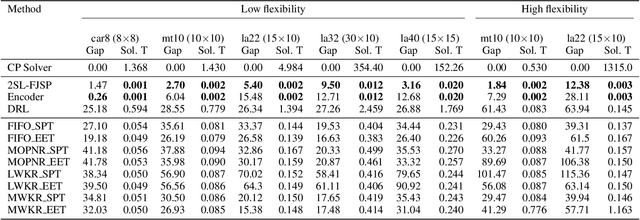
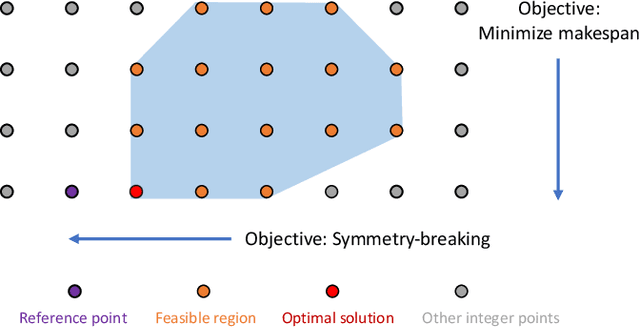
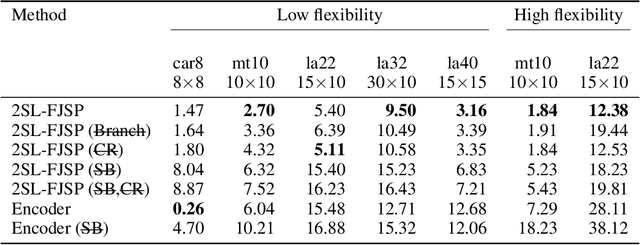
Abstract:The Flexible Job-shop Scheduling Problem (FJSP) is an important combinatorial optimization problem that arises in manufacturing and service settings. FJSP is composed of two subproblems, an assignment problem that assigns tasks to machines, and a scheduling problem that determines the starting times of tasks on their chosen machines. Solving FJSP instances of realistic size and composition is an ongoing challenge even under simplified, deterministic assumptions. Motivated by the inevitable randomness and uncertainties in supply chains, manufacturing, and service operations, this paper investigates the potential of using a deep learning framework to generate fast and accurate approximations for FJSP. In particular, this paper proposes a two-stage learning framework 2SLFJSP that explicitly models the hierarchical nature of FJSP decisions, uses a confidence-aware branching scheme to generate appropriate instances for the scheduling stage from the assignment predictions and leverages a novel symmetry-breaking formulation to improve learnability. 2SL-FJSP is evaluated on instances from the FJSP benchmark library. Results show that 2SL-FJSP can generate high-quality solutions in milliseconds, outperforming a state-of-the-art reinforcement learning approach recently proposed in the literature, and other heuristics commonly used in practice.
Compact Optimization Learning for AC Optimal Power Flow
Jan 21, 2023Abstract:This paper reconsiders end-to-end learning approaches to the Optimal Power Flow (OPF). Existing methods, which learn the input/output mapping of the OPF, suffer from scalability issues due to the high dimensionality of the output space. This paper first shows that the space of optimal solutions can be significantly compressed using principal component analysis (PCA). It then proposes Compact Learning, a new method that learns in a subspace of the principal components before translating the vectors into the original output space. This compression reduces the number of trainable parameters substantially, improving scalability and effectiveness. Compact Learning is evaluated on a variety of test cases from the PGLib with up to 30,000 buses. The paper also shows that the output of Compact Learning can be used to warm-start an exact AC solver to restore feasibility, while bringing significant speed-ups.
FECAM: Frequency Enhanced Channel Attention Mechanism for Time Series Forecasting
Dec 02, 2022Abstract:Time series forecasting is a long-standing challenge due to the real-world information is in various scenario (e.g., energy, weather, traffic, economics, earthquake warning). However some mainstream forecasting model forecasting result is derailed dramatically from ground truth. We believe it's the reason that model's lacking ability of capturing frequency information which richly contains in real world datasets. At present, the mainstream frequency information extraction methods are Fourier transform(FT) based. However, use of FT is problematic due to Gibbs phenomenon. If the values on both sides of sequences differ significantly, oscillatory approximations are observed around both sides and high frequency noise will be introduced. Therefore We propose a novel frequency enhanced channel attention that adaptively modelling frequency interdependencies between channels based on Discrete Cosine Transform which would intrinsically avoid high frequency noise caused by problematic periodity during Fourier Transform, which is defined as Gibbs Phenomenon. We show that this network generalize extremely effectively across six real-world datasets and achieve state-of-the-art performance, we further demonstrate that frequency enhanced channel attention mechanism module can be flexibly applied to different networks. This module can improve the prediction ability of existing mainstream networks, which reduces 35.99% MSE on LSTM, 10.01% on Reformer, 8.71% on Informer, 8.29% on Autoformer, 8.06% on Transformer, etc., at a slight computational cost ,with just a few line of code. Our codes and data are available at https://github.com/Zero-coder/FECAM.
Confidence-Aware Graph Neural Networks for Learning Reliability Assessment Commitments
Nov 28, 2022



Abstract:Reliability Assessment Commitment (RAC) Optimization is increasingly important in grid operations due to larger shares of renewable generations in the generation mix and increased prediction errors. Independent System Operators (ISOs) also aim at using finer time granularities, longer time horizons, and possibly stochastic formulations for additional economic and reliability benefits. The goal of this paper is to address the computational challenges arising in extending the scope of RAC formulations. It presents RACLEARN that (1) uses Graph Neural Networks (GNN) to predict generator commitments and active line constraints, (2) associates a confidence value to each commitment prediction, (3) selects a subset of the high-confidence predictions, which are (4) repaired for feasibility, and (5) seeds a state-of-the-art optimization algorithm with the feasible predictions and the active constraints. Experimental results on exact RAC formulations used by the Midcontinent Independent System Operator (MISO) and an actual transmission network (8965 transmission lines, 6708 buses, 1890 generators, and 6262 load units) show that the RACLEARN framework can speed up RAC optimization by factors ranging from 2 to 4 with negligible loss in solution quality.
 Add to Chrome
Add to Chrome Add to Firefox
Add to Firefox Add to Edge
Add to Edge